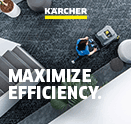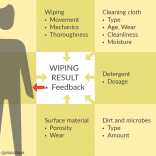Home › magazine › june july 2025 › latest news › Do we put into practice the findings of scientific studies?
Do we put into practice the findings of scientific studies?
15th of May 2025For three years a team of industry experts has been gathering material on cleaning ergonomics and conscious cleaning. In the latest of their exclusive articles for ECJ, Helge Alt from Puhastusekspert in Estonia and Tarja Valkosalo of Propuhtaus Finland ask whether scientific findings are actually being put into practice.
There is quite a lot of scientific research on professional cleaning. Making use of them is the basis for knowledge-based management in cleaning. But are we putting research findings into practice?
In this article, we have compiled research findings, particularly on cleaning furniture surfaces, which are often also contact surfaces. Mechanics play a key role in the cleaning process. For furniture surfaces, this is achieved by muscle work and the correct use of cleaning equipment, because, at least for the time being, cleaning machines and robots cannot be used to any significant extent for cleaning furniture.
Several studies show that microfibre cleaning cloths remove dirt from surfaces better than other materials. This assumes that the cloth is clean, not too worn and correctly wetted to remove the dirt on the surface.
However, an effective dirt-removing material alone is not enough, as it is very easy to spread dirt with a cleaning cloth. This has been studied, particularly in the removal of microbes, and it has been found that microbes from a soiled surface are transferred to several surfaces with the wipe. The spread of dirt can be prevented by folding the cleaning cloth, turning over the new cloth surface and using the right amount of solution to wet the cloth depending on the surface material and dirt. A cleaning cloth that is too dry or too wet can spread dirt.
Increasing the number of cleaning cycles does not necessarily improve the cleaning result. This was shown concretely in a study on the cleanliness of smartphones before and during the Covid-19 pandemic. Shared smartphones during the pandemic were cleaned more often, but more microbial growth was found on them than in pre-pandemic studies. Increasing the frequency is not a solution if the working methods are not mastered.
It is also necessary to consider the working method and the mechanics needed according to the surface material. Studies have shown that hydrophilic surfaces are easier to clean than hydrophobic surfaces. For example, glass is a hydrophilic surface, and a plastic coating is a hydrophobic surface. Worn and porous surfaces are less easy to clean and have more microbes than dense surfaces. In a hospital environment, textile surfaces have been found to have more microbes than hard surfaces, so attention may need to be paid to cleaning textile surfaces, especially if they are contact surfaces.
The cleaning solution used will naturally affect the cleaning result. In daily cleaning, the removal of grease-based dirt is the most challenging and may not be possible without a cleaning solution. It is important to choose the cleaning agent according to the type of dirt to be removed and to dose it according to the instructions for use. Overdosing will lead to a build-up of residual cleaner on surfaces to which dirt can easily adhere. There is an ongoing need for guidance on the correct use of cleaning agents.
In cleaning, we often emphasise the identification of contact surfaces. But this alone is not enough. Cleaning of contact surfaces is often inadequate. Observational studies show that the thoroughness of cleaning ranges from 26% to 75% during maintenance cleaning. The users of the premises and the activity of the premises also influence which surfaces are contact surfaces. Contact surfaces should always be defined on a room-by-room basis.
Feedback and investment in staff skills is a prerequisite for a good outcome. The importance of these has been the subject of much research and their benefits are undeniable. For example, these measures have often helped to improve the thoroughness of cleaning to over 80%.
You may think that the results of studies are self-evident. And yes, we know things in theory, but the only way to know what the situation is in practice is to test. For example, the cleanliness of contact surfaces after cleaning can be assessed by visual inspection, but more accurate results can be obtained by using tools such as UV lamps, ATP tests or microbiological tests. We recommend testing, you might be surprised.












